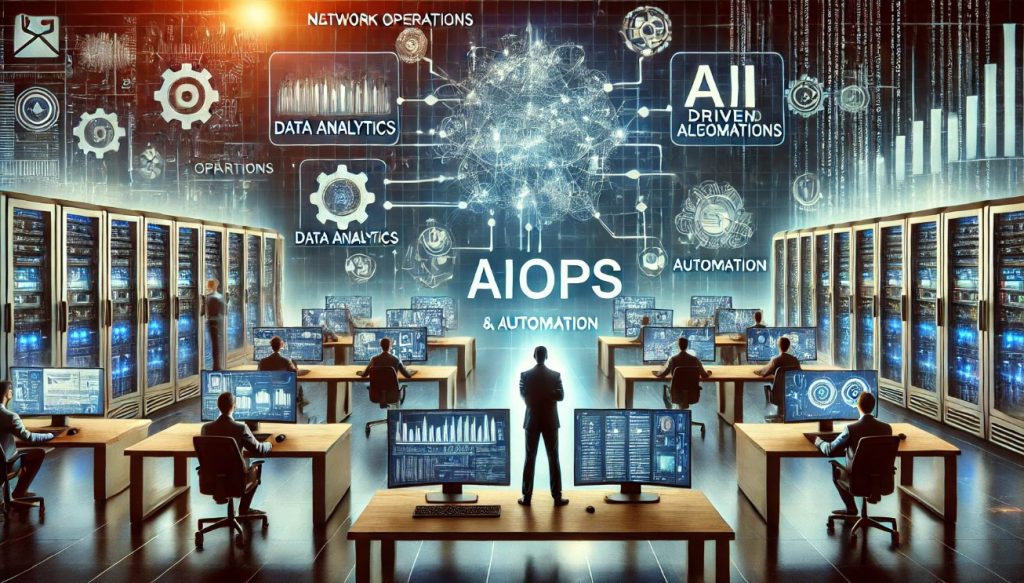Table of Contents
Introduction
The landscape of IT operations is undergoing a transformative shift. As businesses strive to stay competitive in an increasingly digital world, the adoption of advanced technologies such as AIOps (Artificial Intelligence for IT Operations) and automation is becoming essential. These technologies are not just enhancing operational efficiency but are also paving the way for unprecedented innovation.
In this article, we delve into The Future of IT: AIOps and Automation, examining how these advancements are shaping the future of IT.
Understanding AIOps and Automation
What is AIOps?
AIOps combines artificial intelligence, machine learning, and big data analytics to monitor, analyze, and automate IT operations. It aims to enhance the efficiency, reliability, and performance of IT systems by providing real-time insights and automating routine tasks.
What is Automation in IT?
Automation in IT refers to the use of technology to perform tasks with minimal human intervention. This includes automating routine processes such as system monitoring, incident response, and data analysis, thereby reducing manual effort and increasing operational efficiency.
The Synergy of AIOps and Automation
When combined, AIOps and automation create a powerful synergy that transforms IT operations. AIOps provides the intelligence and insights, while automation executes the tasks, leading to a seamless, efficient, and proactive IT environment.
The Benefits of AIOps and Automation
Enhanced Efficiency
- Automation of Routine Tasks: Frees up IT staff to focus on strategic initiatives.
- Proactive Issue Detection: Identifies and resolves issues before they impact operations.
- Streamlined Processes: Automates complex workflows, reducing the time and effort required.
Improved Reliability
- Real-time Monitoring: Continuously monitors IT systems, ensuring optimal performance.
- Predictive Maintenance: Uses predictive analytics to foresee and prevent potential failures.
- Reduced Downtime: Minimizes downtime through proactive issue resolution and automated recovery processes.
Cost Savings
- Resource Optimization: Efficiently allocates resources based on real-time data and demand.
- Reduced Operational Costs: Lowers costs by automating routine tasks and minimizing manual intervention.
- Scalability: Scales operations without a proportional increase in costs.
Enhanced Security
- Continuous Monitoring: Identifies and mitigates security threats in real-time.
- Automated Responses: Automatically responds to security incidents, reducing response time.
- Compliance: Ensures compliance with industry regulations through automated checks and audits.
How AIOps and Automation are Shaping the Future of IT
The Shift to Proactive IT Management
Traditional IT operations are often reactive, addressing issues after they occur. AIOps and automation shift this paradigm to proactive IT management, where potential issues are identified and resolved before they impact the business.
The Rise of Intelligent Automation
Intelligent automation combines AI with automation, allowing IT systems to learn and adapt over time. This leads to smarter, more efficient operations that continuously improve based on real-time data and historical patterns.
The Role of Data in AIOps
Data is the backbone of AIOps. By analyzing vast amounts of data from various sources, AIOps provides actionable insights that drive decision-making and optimize operations. The future of IT will see even greater integration of data analytics and AIOps, leading to more intelligent and adaptive systems.
The Integration of AIOps with DevOps
AIOps is increasingly being integrated with DevOps practices, enhancing the efficiency and effectiveness of the software development lifecycle. This integration ensures that IT operations and development teams work together seamlessly, leading to faster deployment times and more reliable applications.
Key Considerations for Implementing AIOps and Automation
Assessing Your IT Environment
Before implementing AIOps and automation, it’s crucial to assess your current IT environment. Identify the key areas where these technologies can add the most value and address specific challenges.
Choosing the Right Platforms
Select AIOps and automation platforms that meet your specific needs. Consider factors such as data integration, machine learning capabilities, scalability, and ease of use.
Ensuring Data Quality
High-quality data is essential for effective AIOps. Ensure that the data collected is accurate, relevant, and up-to-date. Comprehensive data collection from multiple sources is crucial for providing a holistic view of IT operations.
Training and Development
Provide comprehensive training for your IT staff to ensure they are proficient in using AIOps and automation tools. Continuous learning and development are essential for keeping up with the latest advancements.
Fostering a Culture of Innovation
Encourage a culture of innovation within your IT team. Empower them to explore new technologies and approaches that can enhance IT operations and drive business growth.
FAQs about AIOps and Automation
What is the primary benefit of AIOps?
The primary benefit of AIOps is the automation of routine IT tasks and proactive issue detection, which help in reducing downtime and improving overall efficiency and reliability.
How does automation improve IT operations?
Automation improves IT operations by reducing manual effort, streamlining processes, and enabling faster and more accurate execution of tasks. This leads to increased efficiency, reduced costs, and improved reliability.
Can small businesses benefit from AIOps and automation?
Yes, small businesses can significantly benefit from AIOps and automation. These technologies help optimize resource usage, reduce operational costs, and improve overall efficiency, allowing small businesses to compete more effectively.
How do AIOps and automation enhance security?
AIOps and automation enhance security by continuously monitoring IT systems for threats, automatically responding to incidents, and ensuring compliance with industry regulations through automated checks and audits.
What is the future of AIOps and automation?
The future of AIOps and automation involves greater integration with data analytics, DevOps practices, and intelligent automation. These advancements will lead to smarter, more adaptive IT systems that continuously improve and optimize operations.

Conclusion
The future of IT is being shaped by the transformative power of AIOps and automation. These technologies are revolutionizing IT operations, driving efficiency, reliability, and innovation. By embracing The Future of IT: AIOps and Automation, businesses can achieve unprecedented levels of performance and stay competitive in an increasingly digital world.
Implementing AIOps and automation requires careful planning, high-quality data, continuous training, and a culture of innovation. With the right strategies and tools, the future of IT looks brighter than ever, offering endless possibilities for growth and success.
Embrace the future today and transform your IT operations with AIOps and automation. Unlock new levels of efficiency, reliability, and innovation, and position your business for long-term success in the digital age. Thank you for reading the DevopsRoles page!
